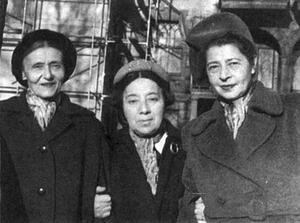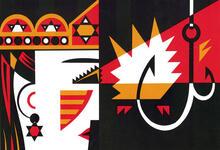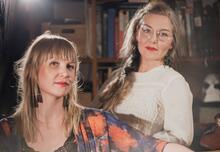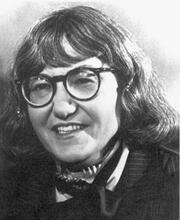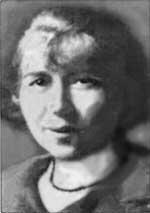Malka Heifetz Tussman
Malka Heifetz Tussman served as a bridge between generations of Yiddish poets from Eastern Europe and American-born Jewish poets who have taken up the task of making Yiddish poetry known to a readership that knows little Yiddish. Born in the late nineteenth century, Tussman immigrated to America with her family in 1912 and began an extensive career as a student, educator, and poet. She published her first literary work in 1918 and was continually published in leading Yiddish newspapers and journals around the world. Tussman has been praised for her unique lyrical style and youthful voice, along with her significance as a woman poet in Yiddish.
Although she declared the natural rhythms of speech and breath as her poetic credo, at the peak of her powers the Yiddish poet Malka Heifetz Tussman introduced into Yiddish one of the most rigid verse forms, the triolet, and mastered another, the sonnet corona. A teacher of Yiddish language and literature in the Midwest and the West, Tussman was awarded the Itzik Manger Prize for Yiddish poetry in Tel Aviv in 1981.
Early Life
Born around the holiday of Lit. "weeks." A one-day festival (two days outside Israel) held on the 6th day of the Hebrew month of Sivan (50 days, or 7 complete weeks, from the first day of Passover) to commemorate the Giving of the Torah on Mount Sinai; Pentecost; "Festival of the First Fruits"; "Festival of the Giving of the Torah"; Azeret (solemn assembly).Shavuot, Tussman herself disputed the exact year, stating it variously as 1893, 1895, or 1896. She considered May 15 her American birthday. Her father was the third generation of the Hasidic Heifetz family to manage an estate in the village of her birth, Khaytshe or Bolshaya-Chaitcha, in the Ukrainian province of Volhynia.
The second of eight children, Malka, like her siblings, was educated in Hebrew, Yiddish, Russian, and English, initially by private tutors and later in the Russian schools in the nearby towns of Norinsk and Korostyen. As a young child, she began to write poems in Russian about the poverty of the neighboring peasants.
Immigration and Teaching Career
Tussman immigrated to America in 1912 and joined family members in Chicago “under terrible conditions she pursued her learning,” as she once wrote. Her first Yiddish short story appeared in 1918, and her first poem was published in 1919. She also wrote in English for the Chicago anarchist publication Alarm in 1914.
After her marriage to the cantor Shloyme Tussman, when she was eighteen years old, and the birth of her two sons (in 1914 and 1918), the family lived in Milwaukee, Wisconsin. In 1924, Tussman began to teach in a Yiddish secular school; at the same time, she studied at the University of Wisconsin. She also studied briefly at the University of California at Berkeley. In 1941 or 1942, the family moved to Los Angeles, where Tussman taught Yiddish elementary and high school students at the Workmen’s Circle School in Boyle Heights. In 1949, she became an instructor of Yiddish language and literature at the University of Judaism. After her husband’s death in 1971, she lived for a year in Israel. Upon her return, she moved to Berkeley, where she resided until her death.
Literary Career
Although she lived far from the centers of Yiddish letters, Tussman’s poems, short stories, and essays appeared in the leading Yiddish newspapers and journals from 1918 onward. These publications included the New York papers Fraye Arbeter Shtime and Der Vokh, as well as the journals Oyfkum, Inzikh, Yidisher Kemfer, Svive, Kinder Zhurnal, and Di Tsukunft, the Warsaw weekly Literarishe Bleter, the Toronto literary magazine Tint un Feder, and the Tel Aviv quarterly Di Goldene Keyt. Her poems were represented in collections of Yiddish poetry, such as Antologye—Mitvest Mayrev [From Midwest to North Pacific] (1933) and Amerike in Yidishn Vort [America in Yiddish literature] (1955). She published six volumes of poetry between 1949 and 1977. Until her death, Tussman continued to work on a seventh, Un Ikh Shmeykhl [And I smile], which is unpublished.
Throughout her career as a poet, Tussman sustained literary friendships and extensive correspondences with Yiddish writers in the United States, Canada, Poland, France, and Israel, including the poets Kalman Marmor, Yankev Glatshteyn, H. Leyvik, Rokhl Korn, Kadya Molodowsky, Melekh Ravitsh, and Avraham Sutzkever. She read poetry of many languages, modern and ancient, and exercised her poetic voice by translating poems by writers as various as Yeats, Rossetti, Auden, and Tagore into Yiddish. By maintaining a ferocious poetic independence from any school or movement, Tussman achieved a compressed lyrical style noted by the critic M. Littvin for its elliptical syntax and free verse rhythms that render the strophe inconspicuous but dense. Avraham Sutzkever praised her poetry for asserting an ever more flexible, youthful voice, the older the poet herself grew.
Legacy
Tussman has significance as a woman poet in Yiddish. Although she did not believe that poetry should be read or written in terms of gender, her poems are fueled by an explicitly female sensuality. Denying any feminist orientation, she nonetheless acknowledged how difficult it was for women writing poetry in Yiddish, even in the heyday of Yiddish poetry in America, to publish their poems in periodicals or to find sponsors for the publication of their books. In an interview she expressed her sense that women who excelled in writing poems for children, such as Kadya Molodowsky, were often categorized by the Yiddish literary establishment as “merely children’s poets,” so that their other work remained unacknowledged. In her later years, she taught informally and befriended a number of younger poets, many American-born and writing in English, who helped disseminate her poetry through their translations, including Eli Katz, Marcia Falk, Kathryn Hellerstein, and Daniel Marlin. She also served as a mentor for some younger Yiddish poets, of whom an Israeli recipient of the Manger Prize, Rokhl Fishman, was the best known. Malka Heifetz Tussman thus served as a bridge between the generations of Yiddish poets who emigrated from Eastern Europe and of those American-born Jewish poets who have taken up the task of making Yiddish poetry known to a readership that knows little Yiddish.
Selected Works
Am I Also You? Translated by Marcia Falk. Berkeley, California: Tree, 1977.
Bleter Faln Not [Leaves do not fall]. Tel Aviv: Yisroel bukh, 1972.
Haynt Iz eybik: Lider [Now is ever: Poems]. Tel Aviv: Yisroel bukh, 1977.
Lider [Poems]. Los Angeles: Malka Heifetz Tussman Book Committee, 1949.
Mild Mayn Vild: Lider [Mild my wild: Poems]. Los Angeles: S.N., 1958.
Shotns fun Gedenkn [Shadows of remembering]. Tel Aviv: Hamenorah, 1965.
Under Dayn Tseykhn: Lider [Under your sign: Poems]. Tel Aviv: Yisroel bukh, 1974.
With Teeth in the Earth: Selected Poems. Translated, edited, and introduced by Marcia Falk. Detroit: Wayne State University Press, 1992.
Bankier, Joanna, Carol Cosman, Doris Earnshaw, et al., eds. The Other Voice: Twentieth-Century Women’s Poetry in Translation (1976).
Diamant, Zeynvl. “Kheyfets-Tuzman, Malke.” In Leksikon fun der Nayer Yidisher Literatur. Vol. 3 (1960): 744–745.
Harshav, Benjamin, and Barbara Harshav, eds. American Yiddish Poetry: A Bilingual Anthology (1986).
Hellerstein, Kathryn. “From Ikh to Zikh: A Journey from ‘I’ to ‘Self’ in Yiddish Poems by Women.” In Gender and Text in Modern Hebrew and Yiddish Literature, edited by Naomi B. Sokoloff, Anne Lapidus Lerner, and Anita Norich (1992): 113–143. New York: Jewish Theological Seminary Press, 1992.
Howe, Irving, Ruth R. Wisse, and Khone Shmeruk, eds. The Penguin Book of Modern Yiddish Verse (1987).
Littvin, M. “Dos Poetishe Verk fun Malke Kheyfets-Tuzman.” Di Goldene Keyt 89 (1976): 80–88.
Sutzkever, Avraham. “Haynt Iz Eybik (Tsum Toyt fun Malke Kheyfets Tuzman).” Di Goldene Keyt 122 (1987): 52.

